Translation by Michael S. Howard, October 2016
Guilielmus Onciacius (Guillaume D'Oncieu), born in Chambéry in 1560, died in 1630, was a doctor of law, scholar and President of the Senate under the Duke of Savoy. He was the author of several legal and philosophical works including Quaestiones academicae (1579), Quaestiones iuris philosophicae (1585), Traité des mainsmortes et conditions taillables (1608), Traité de l'amortissement et abol des mains mortes (1612), Colloquia mixta (1620), and Colloquia mixta in quibus variae juris quaestiones et philosophicae (1626).
Our interest in this author is addressed to the treatise Numeralium locorum decas, printed in Lyon in 1584, a work of extreme importance for the history of tarot in that, in the present state of research, it appears to be the first known document reporting information both on the game and its philosophical and mystical aspects (1). This is the full title of the book, dedicated to Carlo Emanuele, Duke of Savoy, with the place and year of publication: “Guilielmi Onciaci, Numeralium locorum decas: in omni ferè scientiarum genere mysticis referta propositionibus. Ad Serenissimum Carolum Emanuelem Sabaudiae Ducem, Lugduni, apud Carolym Pesnot, 1584”.
In the work, not without a certain artificiality of expression and some obscure passages, D'Oncieu conducts a discussion on the numbers from One to Ten, illustrated through propositions that list the literary places, events, personages, and mythological and religious elements inherent to each of them.
One of the extraordinary things that can be found in the work is the term TAROTICA, attributed by the author not so much to the game of tarot itself, but to everything that pertains to it. It would seem that for the first time we come across in a word, completely unknown until now, a sort of hapax legomenon, but at the time not otherwise known. The term feels to us very modern and consonant with other titles formulated for the purpose of grouping together various aspects of a given subject.
The analysis that the author makes of the Tarot is found in Chapter IV (2), where he deals with the Number Four. There are numerous propositions and figures, quadrate and triangular - explanations for which D'Oncieu cites Plato and Pythagoras - inserted to highlight the mathematical properties of four and its triplicity. Some propositions reported by the Author are these:
Quaternus fic binario suo medio cōgruit,
ut binario modo in se revolvatur.
The number four is a double binary number
in that it contains two identical binary parts.
Quaterna triplicitate divisu est saeculum
The order of the centuries is divided into four [four ages, four eras]
Quaterna triplicitate nominum Dei apud hebreos [p. 240]
A triplicity in groups of four are the names of God among the Jews.
Quaterna Apostolorum [p.241]
Four the Apostles
Quaterna triplicitate distinctus seculi ordo: nēpe duodecim in coelo signis, seu quator signorum trigonis: quorum tria ignea Gemini, Cancer, Leo; tria aërea, Pisces, Aries, Taurus; tria aquea, Sagittarius, Capricornus, Aquarius; tria terrea, perhibētur, Virgo, Libra, Scorpio. [p. 239]
The order of the centuries is divided into four groups of three: in fact there are twelve signs in the sky, four trigons of signs, of which three are of fire: Gemini, Cancer, Leo; three air: Pisces, Aries, Taurus; three water: Sagittarius, Capricorn, Aquarius; three earth: Virgo, Libra, Scorpio.
Quator item in virtutibus: prudentia, iustitia, fortitude, temperantia ...
Four equally in the virtues: prudence, justice, fortitude, temperance...
Quator metaphisica: Esse, essentia, virtute, actione
Four in metaphysics: being, essence, virtue, action
Quaternario quoq; inclusae divinationum species……geomantia, hydromantia, pyromanthia, aëromantia: à terra, aqua, igne, aëre.
Four also; included in the species of divination ...... geomancy, hydromancy, pyromancy, aeromancy: from earth, water, fire, air.
Quaternū aeternae Fontem naturae, animiq', parentem ... Quaternū Aeternae fontem naturae, animiq’, parentem [p. 244]
The quaternity would be the source of eternal nature and of its generating soul
Quaternis trinum unumq’, Deum inesse percipi posset [p. 249]
The one God is perceived as three in the quaternity.
Quator quaternae pares 2,4,6,8 ac impares 1,3,5,7
Four even 1,3,5,7 and odd 2,4,6,8 numbers of the quaternity.
Etc.
Below is the passage in the original work on the Tarot, whose division by four is considered by the author the most perfect and admirable that exists:
P. 261
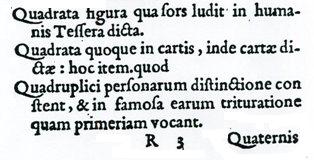
P. 262
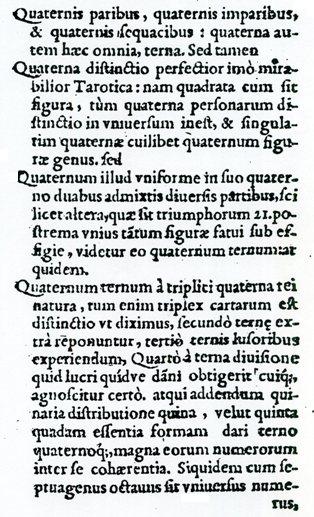
P. 263
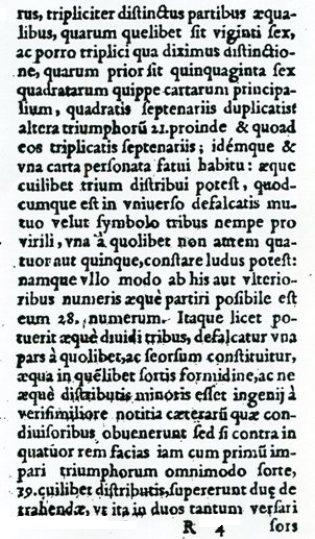
P. 264
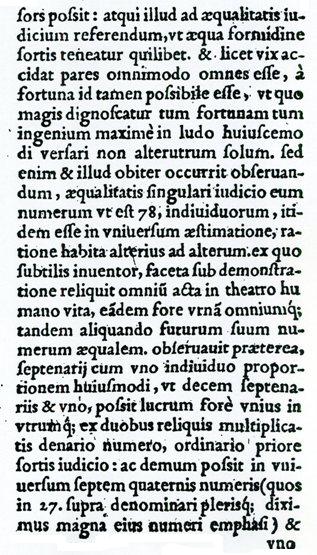
P. 26
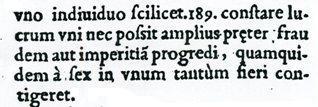
Here is the text transcribed:
"Quadrata figura qua sors ludit in humanis Tessera dicta.
Quadrata quoque in cartis, inde cartae dictae: hoc idem quod
Quadruplici personarum distinctione constent, & in famosa earum trituratione quam primeriam vocant.
Quaternis paribus, quaternis imparibus, & quaternis sequacibus: quaterna autem haec omnia, terna.
Sed tamen
Quaterna distinctio perfectior imó mirabilior Tarotica: nam quadrata cum sit figura, tùm quaterna personarum distinctio in universum inest; & singularim quaternae cuilibet quaternum figurae genus. sed
Quaternum illud uniforme in suo quaterno duabus admixtis diversis partibus, scilicet altera, quae sit triumphorum. 21 postrema unius tātum figurae fatui sub effigie, videtur eo quaternum ternum: at quidem.
Quaternum ternum à triplici quaterna rei natura, tum enim triplex cartarum est distinctio ut diximus, secundò terne extrà reponuntur, tertiò ternis lusoribus experiendum, Quartò à terna divisione quid lucri quídue dāni obtigerit cuiq’;, agnositur certò. atqui addendum quinaria distributione quina, velut quinta quadam essentia formam dari terno quaternoq’;, magna eorum numerorum inter se cohaerentia. Siquidem cum septuagenus octavus sit universus numerus, tripliciter distinctus partibus aequalibus, quarum quelibet sit viginti sex, ac porro triplici qua diximus distinctione, quarum prior sit quinquaginta sex quadratarum quippe cartarum principalium, quadratis septenariis duplicatis: altera triumphorū 21. proinde & quoad eos triplicatis septenariis; idémque & una carta personata fatui habitu: aeque cuilibet trium distribui potest, quodcumque est in universo defalcatis mutuo velut symbolo tribus nempe pro virili, una à quolibet non autem quatuor aut quinque, constare ludus potest: namque ullo modo ab his aut ulterioribus numeris aequè partiri posibile est eum 28. numerum. Itaque licet potuerit aequè dividi tribus, defalcatur una pars à quolibet, ac seorsum constituitur, aequa in quēlibet sortis formidine, ac ne aequè distributis minoris esset ingenij à verisimiliore notitia caeterarū quae condivisoribus obvenerunt sed si contra in quatúor rem facias iam cum primū impari triumphorum omnimodo sorte, 39 cuilibet distributis, supererunt due de trahendae, ut ita in duos tantum versari sors possit: atqui illud ad aequalitatis iudicium referendum, ut aequa formidine sortis teneatur quilibet. & licet vix accidat pares omnimodo omnes esse, à fortuna id tamen possibile esse, ut quo magis dignoscatur tum fortunam tum ingenium maximè in ludo huiuscemo di versari non alterutrum solum. sed enim & illum obiter occorri observandum, aequalitatis singulari iudicio eum numerum ut est 78, individuorum, itidem esse in universum aestimatione, ratione habita alterius ad alterum. ex quo subtilis inventor, faceta sub demonstratione reliquit omniū acta in theatro humano vita, eādem fore urnā omniumq’; tandem aliquando futurum suum numerum aequalem obíeruavit praeterea, septenarij cum uno individuo proportionem huiusmodi, ut decem septenariis & uno, possit lucrum forè unius in utrumq’; ex duobus reliquis multiplicatis denario numero, ordinario priore sortis iudicio: ac demum possit in universum septem quaternis numeris (quos in 27. supra denominari plerisq; diximus magna eius numeri emphasi) & uno individuo scilicet. 189. constare lucrum uni nec possit amplius preter fraudem aut imperitiā progredi, quamquidem à sex in unum tantùm fieri contigeret".
As we have said above, the passage concerning the Tarot contains information of both a ludic and philosophical character. The ludic aspects, described in a somewhat obscure form, would be fully decipherable if the rules in force in section XVI were known.
The philosophical content has a better fate; we find that 78, the total number of cards, iis the same as "in the reckoning" of the universe, and that the number of sides (four) of the same cards, leads them to "enter" into the Universe (consider the four seasons, four cardinal points, etc., concepts reported by the author in his propositions); we
find also that the division of the cards into the suits, 21 Triumphs, and the Fool card makes the quaternity triune, just as God is triune in the quaternity, the concept expressed in the proposition “Quaternis Trinum unumq' = Deum Inesse percipi posset” (The one God is perceived as three in the quaternity), considering that "the quaternity is three due to the threefold nature of this quaternity", according to the philosophical thought that knows God as Triune, one God and three distinct persons (Father, Son and Holy Spirit).
We find, further, that the seven (septenary), by which the 21 Triumphs are divided into three equal parts (as we have seen, the Fool is considered in its own right), expresses a value of completeness meaning "all", the sacred number to the Hebrews, who used it especially in their apocalyptic writings, with its seven heavens, seven rivers, of mountains, and in the liturgy with seven altars, seven sacred springs, seven branches of the candlestick, seven anointings with oil, seven pairs of clean animals entering Noah’s ark, also a highly symbolic number for Christianity with its seven sacraments and tseven gifts of the Holy Spirit. And further, in the division by five of the quaternity, the quintenary brings almost a form of the Quinta Essentia to the triple and quadrupal.
In short, the conformation of a tarot deck to numerology reflects the order of the universe in the total number of cards, in its division into four (the four suits, but also the entire deck, the number cards, the triumphs and the Fool), while the aspect of triplicity (suits, triumphs and Fool) connected to the quadruple (the entire deck) is to be related to the threefold nature of the Divine, which is triple in the quadruple as described above. Tarot cards become therefore the representation of a man who "lives his life in the theater of the world" while the numerological aspects that characterize the deck are to be interpreted according to a philosophical-mystical key, "the reciprocal correspondence of numbers being great", as we have repeatedly stressed in several of our essays (3).
Since the passage contains several obscure aspects, at this time we also provide a literal translation, reserving, through a more detailed analysis, to modify it according to a precise understanding of the different concepts:
“The quadrate figure with which fate plays among men is called the Tessera. [Tessera is the Greek name that in Latin means one of a pair of dice, one die].
Quadrate is also in cards, as these are called quadrate. The same thing is why there consists a quadruple distinction of persons [single cards] in the popular and destructive practice of those cards they call Primiera.
Four in the even [para, also meaning “equal” - trans.], four in the odd [impara, also meaning “unequal’ – trans.], and four in the rest: on the other hand all this quaternity is also ternary.
However, the distinction by four is the most perfect, even the most admirable, of the Tarot: from the moment that the figure is made quadrate, the distinction by four of the figures enters into the universe, and singularly in any quaternity corresponds a quadruple typology of figures.
But this is uniform in its four elements with the addition of two different parts: namely the one that consists of 21 Triumphs and last only a single figure under the species of Fool; so the quaternity certainly seems trinitary.
The quaternity is triple because of the threefold nature of this quaternity, then in fact the distinction of the cards is threefold as we have said, and second are given three by three, and thirdly, is experienced with three players.
Fourth, from the division by three is known for certain what gain or loss happens to anyone, and there needs to be added the distributions by five, the quintinary as if bestowing a certain form of the Fifth Essence to the ternary and quaternary the reciprocal correspondence of the numbers being great.
If it is true that the total number of the universe is 78 divided into three equal parts, of which any one is 26, and continuing for the threefold distinction that we have said, of which the first part is 56, which is indeed the number of main quadrate cards, doubling the quadrated septenary, the other part is the 21 Triumphs, which can be regarded as the septenary being multiplied by three; also one card alone dressed as a Fool; and it can be distributed equally to any of the three. [[At this point the language of Andrea's translation into Italian becomes too difficult for this translator. The reader is referred to my translation of Girolamo Zorli's Italian version that follows here, as well as to Marco Ponzi's English translation at http://www.tarotpedia.com/wiki/D'Oncieu:Numeralium_Locorum_Decas]
We have given the preceding text that to our associate Girolamo Zorli, an expert in the history of games, for his consideration and interpretation from a ludic point of view. Zorli has provided an excellent discussion, which we give below:
Girolamo Zorli: Interpretation of the passage relative to the game (4)
Key to the solution of the riddle:
Figure: representation, that is, part of the game, so a single card.
Quaternum: Fourth part or portion of the homogenous deck, i.e. suit
Distinction: belonging to a suit
Person: single card
Sor-sortis: distribution (see Folengo)
Universum: the whole, that is, the deck
Shown in italics is the sometimes obscure Latin text transcribed by Prof. Vitali, with my free annotated translation. The passsages of ludic interest are highlighted in bold.
Text and Translation
Dice, Primiera and Tarot
Quadrata figura qua sors ludit in humanis Tessera dicta. Quadrata quoque in cartis, inde cartae dictae: hoc idem quod
The quadrate figure with which Fortune plays among men is called a die [one of a pair of dice]. And quadrate also in the cards (1), and it is called a playing card: it is the same.
Quadruplici personarum distinctione constent, & in famosa earum trituratione quam primeriam vocant. Quaternis paribus, quaternis imparibus, & quaternis sequacibus: quaterna autem haec omnia, terna.
Fourfold is the distinction of the cards, also in their notorious destructive game called Primiera. Quadruples of pari cards (equal / the same suit), quadruples of impari (other / different suits), and quadruples of consecutive cards: all these are of four cards and three cards (2).
Sed tamen quaterna distinctio perfectior imó mirabilior Tarotica (3) : nam quadrata cum sit figura, tùm quaterna personarum distinctio in universum inest; & singularim quaternae cuilibet quaternum figurae genus.
The best distinction, also the most admirable, of the fourfold distinctions (the four suits) is that of the Tarot: in fact the fourfold distinction is included in the whole (universum, for us the deck), and individually fourfold is the genus of any quarter of the cards.
Sed quaternum illud uniforme in suo quaterno duabus admixtis diversis partibus, scilicet altera, quae sit triumphorum 21 postrema unius tātum figurae fatui sub effigie, videtur eo quaternum ternum: at quidem.
The fourth part of the deck (the suit) is uniform and fourfold. Mixing in the other two parts, one of which is composed of 21 triumphs and the other of a single figure portrayed as a fool, results in a triplicity from the quadruplicity.
Quaternum ternum à triplici quaterna rei natura, tum enim triplex cartarum est distinctio ut diximus, secundò terne extrà reponuntur, tertiò ternis lusoribus experiendum, Quartò à terna divisione quid lucri quídque dāni obtigerit cuiq’; agnositur certò atqui addendum quinaria distributione quina, velut quinta quadam essentia formam dari terno quaternoq’;
The triplicity of the fourfold is in the triple nature of the fourfold. In fact, as we have said, (in the Tarot) the division of the cards is threefold, in the second place three cards are discarded, thirdly the game is played by three players, in fourth place at the end of the game note is taken of the three portions of receipts and penalties (4) obtained by each of the three players. Added to this is that the distribution is five cards for five times, which is a certain form of the quintessence given to the triplicity and quadruplicity.
The Tarot pack
magna eorum numerorum inter se cohaerentia. Siquidem cum septuagenus octavus sit universus numerus, tripliciter distinctus partibus aequalibus, quarum quelibet sit viginti sex, ac porro triplici qua diximus distinctione, quarum prior sit quinquaginta sex quadratarum quippe cartarum principalium, quadratis septenariis duplicatis: altera triumphorū 21. proinde & quoad eos triplicatis septenariis; idémque & una carta personata fatui habitu:
Great is the coherence among these numbers. If it is true that the total number of cards in the deck is 78, dividing this number into three equal parts we get 26. Continuing with its three orders we have said, the first of which is 56 pieces, this number is actually the number of ordinary cards. But 56 is the double of four septenaries (4x7x2 = 56). The second part is of 21 triumphs, which is equivalent to three septenaries (3x7 = 21), and the third is one card with the dress of the Fool,
The discards and distribution in Three-handed Tarot
aeque cuilibet trium distribui potest, quodcumque est in universo defalcatis mutuo velut symbolo tribus nempe pro virili, una à quolibet non autem quatuor aut quinque, constare ludus potest: namque ullo modo ab his aut ulterioribus numeris aequè partiri posibile est eum 28.
and this card (the Fool) can be equally distributed to any of the three players, whatever remains once three cards are discarded. The game starts correctly when three cards are discarded, a discard that is performed interchangeably or per unit (turn?) per player once for each and not four or five times. In no other way or with any other number is it permitted to divide, if not giving to those who discard exactly 28 cards.
Itaque licet potuerit aequè dividi tribus, defalcatur una pars à quolibet, ac seorsum constituitur, aequa in quēlibet sortis formidine, ac ne aequè distributis minoris esset ingenij à verisimiliore notitia caeterarū quae condivisoribus obvenerunt
But the deck could be validly distributed in three parts after having one card, making then the discard of one card from each (of the three players). Everyone would receive a distribution of his own, with some minor fear of randomness, and thus a more equitable distribution and greater verisimilitude requiring less speculative capacity to identify the other cards in the hands of the opponents.
Equitableness of the Distribution
sed si contra in quatúor rem facias iam cum primū impari triumphorum omnimodo sorte, 39 cuilibet distributis, supererunt due de trahendae, ut ita in duos tantum versari sors possit: atqui illud ad aequalitatis iudicium referendum, ut aequa formidine sortis teneatur quilibet.
But if instead the game is among four players, unequal distribution already in the first place made in any way, distributing to the players 19 (39) cards each, there would remain only two to discard. And this would bring back a judgment of equality, so that each is kept by an equal fear of the distribution.
& licet vix accidat pares omnimodo omnes esse, à fortuna id tamen possibile esse, ut quo magis dignoscatur tum fortunam tum ingenium maximè in ludo huiuscemodi versari non alterutrum solum.
And if it can hardly happen that everything is equal in every way, yet this can make fortune possible so that above all during the game is distinguished fortune or ingenuity for understanding the situation, and not only the one or the other.
sed enim & illum obiter occurri observandum, aequalitatis singulari iudicio eum numerum ut est 78, individuorum, itidem esse in universum aestimatione, ratione habita alterius ad alterum.
In fact it should be noted incidentally, with particular judgment of equality, that the number of 78 pieces is the total number of the deck, bearing in mind the differences between one piece and another.
For a discussion of the numerological aspects and their significance, see what is written above by Prof. Vitali.
_____________
(1) The intuition of game pieces made of different materials is interesting and modern. Today, we are pretty sure that the cards were developed in the direction dice-domino-cards.
(2) The allusion seems to be to the principal combinations of the game of Primiera: the flusso [flush] of four cards of the same suit, the primiera of four cards of different suits, the 55 of three cards of the same suit in sequential hierarchy.
(3) “Tarotica” is a neologism found here for the first time. D’Oncieu invented it from the French term “tarot”. The Italian version would have been the less elegant "tarocchità."
(4) The text does not clearly leave room for conjecture that at the end of the hand the three divide in proportion to the points they attain. The word “dannum” for damages, penalties, loss, power seems to allude to negative scores, of which we know nothing.
Notes
1 - Some information about aspects of the game were reported by Flavio Alberto Lollius and Vincenzo Imperiali in their works of the XVIth century. See the essay Tarot in Literature I
2 - Pp. 261-265. [Translator’s note: Three copies of the book are currently online, of which the easiest to read is at
atttp://books.google.it/books?id=6JJa8oeJoPYC&dq=guillaume%20d%27oncieu%20numeralia&hl=it&source=gbs_similarbooks].
3 - Read the section entitled "Celestial Harmony" in the essay The History of Tarot
4 - A broader discussion by Zorli on the ludic aspects reported by D' Oncieu is located on the site http://www.tretre.it in the article
http://www.tretre.it/menu/accademia-del-tre/documenti-e-articoli/i-tarocchi-e-la-primiera-di-doncieu-1584/.
[Translator’s note: another effort to translate this section into English, with notes, is at http://www.tarotpedia.com/wiki/D%27Oncieu:Numeralium_Locorum_Decas].
Copyright Andrea Vitali